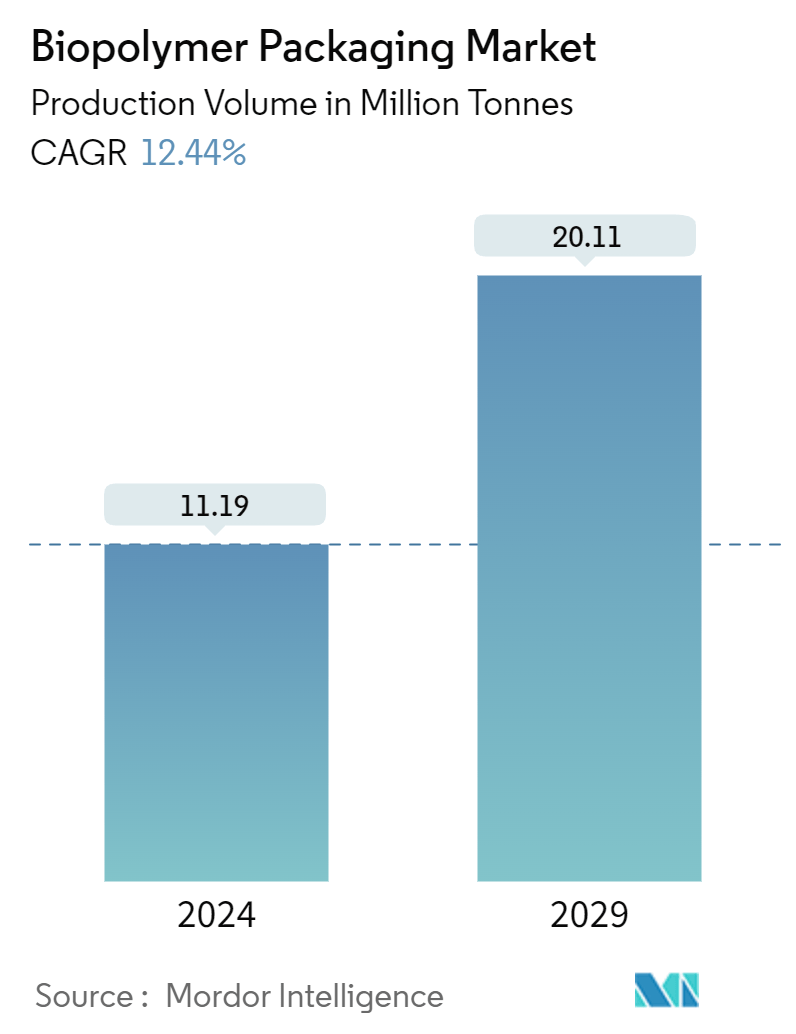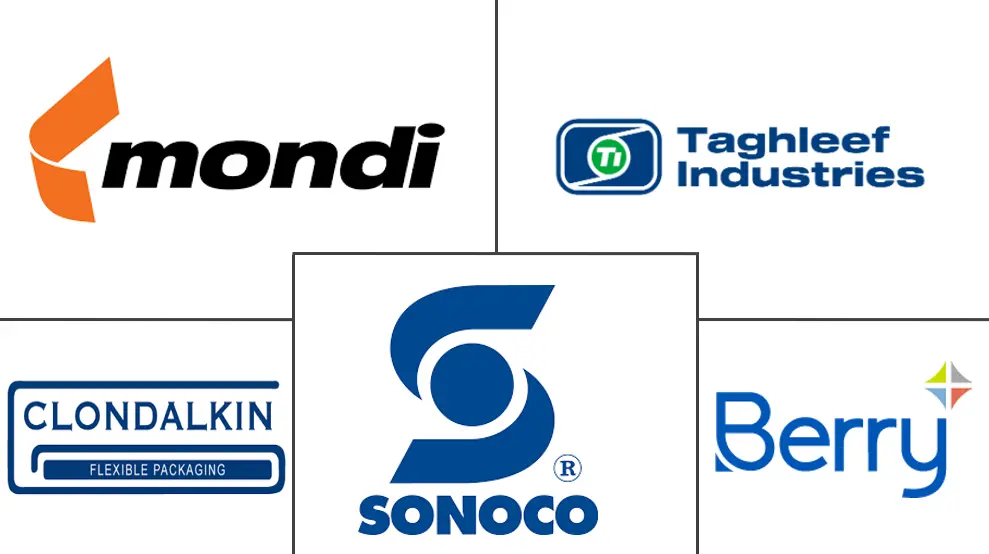Market Size of Biopolymer Packaging Industry

| Study Period | 2019 - 2029 |
| Market Volume (2024) | 11.19 Million tonnes |
| Market Volume (2029) | 20.11 Million tonnes |
| CAGR (2024 - 2029) | 12.44 % |
| Fastest Growing Market | Asia Pacific |
| Largest Market | North America |
| Market Concentration | Medium |
Major Players
*Disclaimer: Major Players sorted in no particular order |
Biopolymer Packaging Market Analysis
The Biopolymer Packaging Market size in terms of production volume is expected to grow from 11.19 Million tonnes in 2024 to 20.11 Million tonnes by 2029, at a CAGR of 12.44% during the forecast period (2024-2029).
Increasing environmental concerns owing to the use of synthetic polymers, coupled with rising strict regulations on plastic packaging, are some of the crucial factors contributing to the growth of the biopolymers packaging market.
A variety of agricultural by-products serve as raw materials for cost-effective, renewable, and biodegradable food packaging. The chemical structure of biodegradable polymers features ester and amide bonds attributed to their biodegradable functional groups.
As regulations tighten on plastic bag usage, wholesalers and retailers are increasingly adopting eco-friendly packaging. This rising inclination toward sustainable packaging is poised to bolster the biopolymers packaging market. Furthermore, alternatives like bio-based, biodegradable, and compostable plastics present a more sustainable choice compared to their fossil-based, non-biodegradable counterparts.
Biopolymer packaging materials not only offer an eco-friendly solution but also benefit from the affordability and abundance of their raw materials. The bio-polymers packaging market is set for robust growth, driven largely by demand from the food and pharmaceutical industries. In response to sustainability concerns and the potential of biodegradable plastic packaging, countries in Asia-Pacific, notably India, China, and Japan, alongside several European nations, are increasingly adopting bio-polymer packaging.
In recent years, biocomposites have emerged as a leading focus for active food packaging, enhancing materials in direct contact with food. These advanced biocomposites are paving the way for innovative food packaging materials boasting superior mechanical, barrier, antioxidant, and antimicrobial attributes.
Nonetheless, the adoption of bio-based biodegradable synthetic biopolymers faces hurdles. Their higher costs, surpassing those of conventional petroleum-derived non-biodegradable materials, coupled with certain limitations, challenge their competitiveness against traditional plastics. As a result, positioning bio-based biodegradable synthetic biopolymers as direct replacements for conventional plastics remains a formidable obstacle.
Biopolymer Packaging Industry Segmentation
Biopolymers, natural polymers synthesized by living organisms, consist of monomeric units linked covalently in chains, forming larger molecules. They are primarily categorized into three classes, namely polynucleotides, polypeptides, and polysaccharides, based on the monomers utilized and the resulting biopolymer structure.
The biopolymers packaging market is segmented by material type (non-biodegradable [PET, PA, PTT, and other non-biodegradable materials] and biodegradable [PLA, PBAT, starch blends, and other biodegradable materials]), end user (food and beverage, retail, healthcare, and personal care/home care), and geography (North America [the United States and Canada], Europe [the United Kingdom, Germany, France, Italy, Spain, and Rest of Europe], Asia-Pacific [China, Japan, India, and Australia], Latin America [Brazil, Argentina, and Mexico], Middle East and Africa [Saudi Arabia, South Africa, and Egypt]). The report offers market sizes and forecasts in terms of volume (tonnes) for all the above segments.
| By Material Type | ||||||
| ||||||
|
| By Products | |
| Bags | |
| Pouches | |
| Films |
| By End User | |
| Food and Beverages | |
| Retail | |
| Other End User |
| By Geography*** | |||||||
| |||||||
| |||||||
| |||||||
| Australia and New Zealand | |||||||
| |||||||
|
Biopolymer Packaging Market Size Summary
The biopolymer packaging market is poised for significant growth, driven by the increasing demand for sustainable and eco-friendly packaging solutions. Biopolymers, derived from renewable sources like plants and animals, are gaining traction due to their potential to replace conventional plastics, especially in the context of rising oil prices and environmental concerns. The market is witnessing advancements in processing technologies that enhance the properties of biopolymers, making them viable alternatives to traditional materials. Innovations in biopolymer formulations are addressing various packaging needs, such as food preservation and protection, by offering improved mechanical, barrier, antioxidant, and antimicrobial properties. The growing emphasis on waste management and the reduction of greenhouse gas emissions further bolster the market's expansion, as companies strive to meet regulatory requirements and consumer preferences for sustainable products.
The Asia-Pacific region stands out as a major consumer and producer of biopolymers, with countries like China and India leading the charge due to increasing environmental awareness and government regulations promoting sustainable packaging. The region's burgeoning food and beverage sector, coupled with the rise of organized retail, is driving the demand for innovative packaging solutions. The market is moderately consolidated, with key players like Mondi Group and Taghleef Industries Inc. leveraging their competitive advantages through continuous product innovation and strategic partnerships. As global awareness and investment in biodegradable plastics grow, the biopolymer packaging market is expected to see substantial opportunities, particularly with the ongoing shift towards compostable and recyclable materials in response to regulatory pressures and consumer demand.
Biopolymer Packaging Market Size - Table of Contents
-
1. MARKET INSIGHTS
-
1.1 Market Overview
-
1.2 Industry Attractiveness - Porter's Five Forces Analysis
-
1.2.1 Bargaining Power of Buyers/Consumers
-
1.2.2 Bargaining Power of Suppliers
-
1.2.3 Threat of New Entrants
-
1.2.4 Threat of Substitute Products
-
1.2.5 Intensity of Competitive Rivalry
-
-
-
2. MARKET SEGMENTATION
-
2.1 By Material Type
-
2.1.1 Non-biodegradable
-
2.1.1.1 PET
-
2.1.1.2 PA
-
2.1.1.3 PTT
-
2.1.1.4 Other Non-biodegradable Materials
-
-
2.1.2 Biodegradable
-
2.1.2.1 PLA
-
2.1.2.2 Starch Blends
-
2.1.2.3 PBAT
-
2.1.2.4 Other Biodegradable Materials
-
-
-
2.2 By Products
-
2.2.1 Bags
-
2.2.2 Pouches
-
2.2.3 Films
-
-
2.3 By End User
-
2.3.1 Food and Beverages
-
2.3.2 Retail
-
2.3.3 Other End User
-
-
2.4 By Geography***
-
2.4.1 North America
-
2.4.1.1 United States
-
2.4.1.2 Canada
-
-
2.4.2 Europe
-
2.4.2.1 United Kingdom
-
2.4.2.2 Germany
-
2.4.2.3 France
-
2.4.2.4 Italy
-
2.4.2.5 Spain
-
-
2.4.3 Asia
-
2.4.3.1 China
-
2.4.3.2 Japan
-
2.4.3.3 India
-
-
2.4.4 Australia and New Zealand
-
2.4.5 Latin America
-
2.4.5.1 Brazil
-
2.4.5.2 Argentina
-
2.4.5.3 Mexico
-
-
2.4.6 Middle East and Africa
-
2.4.6.1 Saudi Arabia
-
2.4.6.2 South Africa
-
2.4.6.3 Egypt
-
-
-
Biopolymer Packaging Market Size FAQs
How big is the Biopolymer Packaging Market?
The Biopolymer Packaging Market size is expected to reach 11.19 million tonnes in 2024 and grow at a CAGR of 12.44% to reach 20.11 million tonnes by 2029.
What is the current Biopolymer Packaging Market size?
In 2024, the Biopolymer Packaging Market size is expected to reach 11.19 million tonnes.

